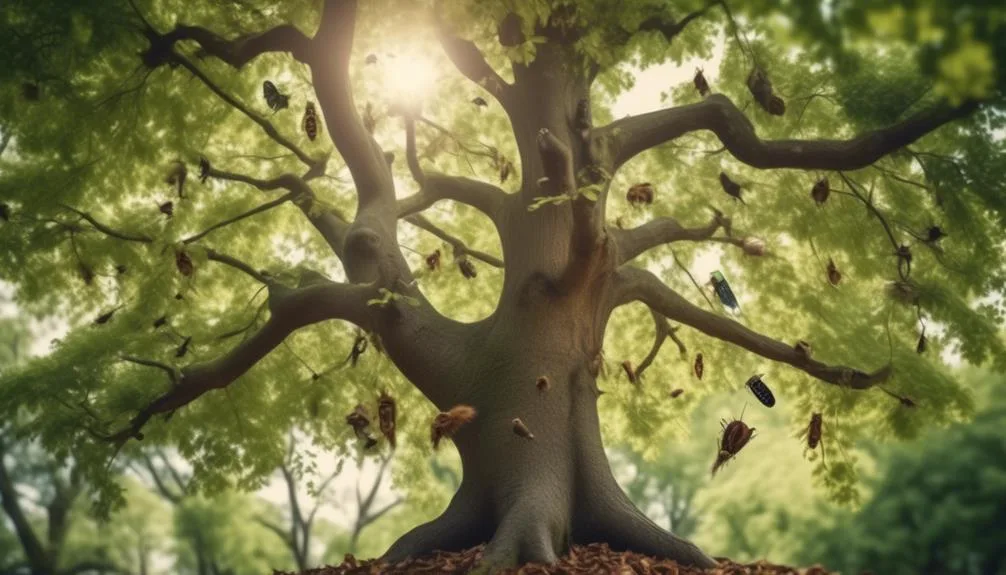As you walk through a forest, you might come across tall elm trees. Have you ever wondered how these trees help wildlife?
Let's explore the connection between elm trees and the animals that live around them. We'll discover the vital role these trees play in supporting nature's balance.
Elm Trees: Natural Wildlife Habitats
Elm trees provide essential natural wildlife habitats, fostering diverse ecosystems that support a wide range of animal species. Their broad canopies and dense foliage provide shelter and nesting sites for birds, while the abundant seeds and leaves attract various small mammals and insects.
These trees also encourage wildlife interactions, creating a dynamic environment where different species coexist and depend on each other for food, shelter, and survival. Additionally, their presence contributes to tree diversity, playing a crucial role in maintaining balanced and thriving ecosystems.
Elm trees offer a variety of niches and resources, promoting a rich and interconnected web of life. From providing food and shelter to facilitating wildlife interactions, these majestic trees are integral to the health and vitality of many animal species.
Elm Trees: Food Sources for Wildlife
Nestled among the lush foliage of elm trees, a diverse array of wildlife finds sustenance in the form of seeds, leaves, and other natural resources. Elm trees offer a bounty of benefits for wildlife foraging opportunities.
The seeds of elm trees are a vital food source for birds such as finches and sparrows, providing them with essential nutrients for survival. In addition, the leaves of elm trees are a favored food for caterpillars of various butterfly species, supporting their life cycle and contributing to the overall biodiversity of the ecosystem.
Squirrels and other small mammals also rely on elm tree seeds as part of their diet, further demonstrating the crucial role of elm trees in providing food for a wide range of wildlife. The diverse food sources provided by elm trees make them an invaluable asset to wildlife habitats.
Elm Trees: Shelter and Nesting Sites
Amidst the verdant canopy of elm trees, wildlife find not only nourishment but also safe havens and nesting grounds, contributing to the rich tapestry of life within these majestic trees.
Elm trees provide shelter benefits for various wildlife species. The dense foliage and sturdy branches offer protection from predators and harsh weather conditions, creating a secure environment for birds, squirrels, and other small animals.
Additionally, the unique bark patterns of elm trees create natural crevices and hollows that serve as ideal nesting preferences for birds such as owls, woodpeckers, and warblers. These nesting sites offer a safe space for raising their young, contributing to the overall biodiversity and ecological balance within the elm tree habitats.
As a result, elm trees play a vital role in providing essential shelter and nesting opportunities for a diverse array of wildlife.
Elm Trees: Impact on Biodiversity
In the intricate web of life within elm tree habitats, the diverse flora and fauna interact to foster a thriving ecosystem, amplifying the overall biodiversity of the area.
Elm trees, with their expansive canopies, provide ample shade and shelter for a wide array of species, from birds and insects to small mammals and plants. The canopy coverage not only offers protection from predators but also creates microhabitats for various organisms to thrive.
This, in turn, contributes to an increase in species richness within the elm tree habitat. The rich biodiversity supported by elm trees plays a crucial role in maintaining ecological balance and resilience.
It enhances the overall health of the ecosystem, promoting a sustainable environment where different species coexist and interact, ultimately benefiting wildlife and the surrounding natural landscape.
Elm Trees: Conservation and Restoration Efforts
Conservation and restoration efforts for elm trees involve implementing strategic measures to protect and revive these majestic trees, ensuring their continued presence in the natural landscape.
To engage the audience, consider the following:
- Conservation Efforts
- Collaborate with local communities to raise awareness about the importance of elm trees in the ecosystem.
- Establish conservation programs aimed at preserving elm tree populations in areas prone to tree diseases.
Restoration efforts often focus on enhancing tree disease resistance, ensuring the survival of elm trees for future generations.
Conclusion
Elm trees are a vital component of wildlife habitats, providing food and shelter for various species. Their preservation is crucial for maintaining biodiversity and the overall health of ecosystems.
Whether in urban or rural areas, these trees contribute significantly to the natural world's beauty and diversity. Conserving elm trees is essential for sustaining the wildlife they support and ensuring a thriving environment for all.

My interest in trees started when I first saw the giant sequoias in Yosemite.
I was a teenager then, and I remember thinking, “I need to learn more about this.”
That moment stuck with me.
A few years later, I went on to study forestry at Michigan Tech.
Since graduating, I’ve worked in a mix of hands-on tree care and community education.
I’ve spent over ten years helping people understand how to plant, maintain, and protect the trees in their neighborhoods.
I don’t see trees as just part of the landscape.
They are living things that make a real difference in our daily lives.
